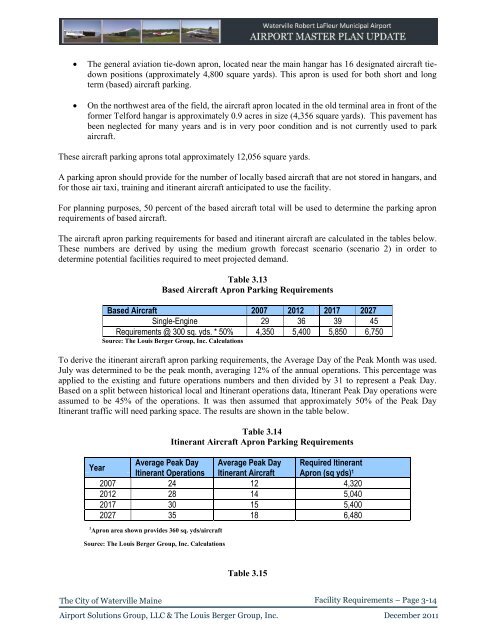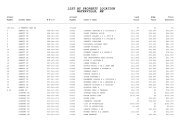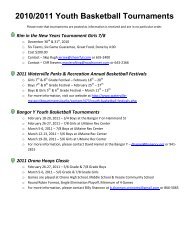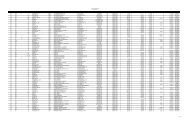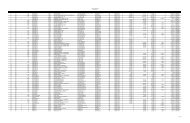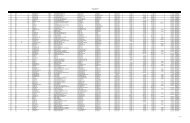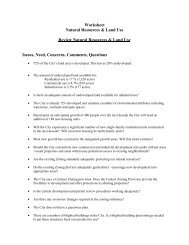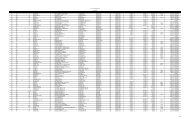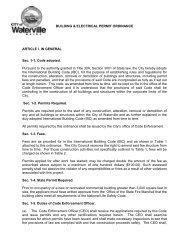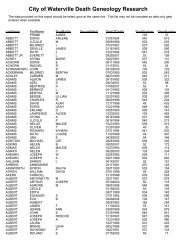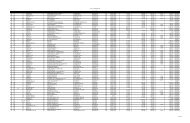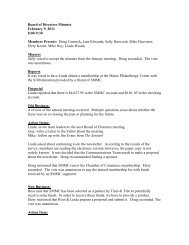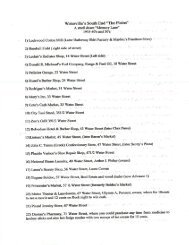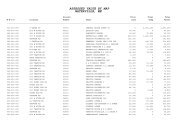Airport Master Plan 2012 - City of Waterville
Airport Master Plan 2012 - City of Waterville
Airport Master Plan 2012 - City of Waterville
You also want an ePaper? Increase the reach of your titles
YUMPU automatically turns print PDFs into web optimized ePapers that Google loves.
The general aviation tie-down apron, located near the main hangar has 16 designated aircraft tiedown<br />
positions (approximately 4,800 square yards). This apron is used for both short and long<br />
term (based) aircraft parking.<br />
On the northwest area <strong>of</strong> the field, the aircraft apron located in the old terminal area in front <strong>of</strong> the<br />
former Telford hangar is approximately 0.9 acres in size (4,356 square yards). This pavement has<br />
been neglected for many years and is in very poor condition and is not currently used to park<br />
aircraft.<br />
These aircraft parking aprons total approximately 12,056 square yards.<br />
A parking apron should provide for the number <strong>of</strong> locally based aircraft that are not stored in hangars, and<br />
for those air taxi, training and itinerant aircraft anticipated to use the facility.<br />
For planning purposes, 50 percent <strong>of</strong> the based aircraft total will be used to determine the parking apron<br />
requirements <strong>of</strong> based aircraft.<br />
The aircraft apron parking requirements for based and itinerant aircraft are calculated in the tables below.<br />
These numbers are derived by using the medium growth forecast scenario (scenario 2) in order to<br />
determine potential facilities required to meet projected demand.<br />
Table 3.13<br />
Based Aircraft Apron Parking Requirements<br />
Based Aircraft 2007 <strong>2012</strong> 2017 2027<br />
Single-Engine 29 36 39 45<br />
Requirements @ 300 sq. yds. * 50% 4,350 5,400 5,850 6,750<br />
Source: The Louis Berger Group, Inc. Calculations<br />
To derive the itinerant aircraft apron parking requirements, the Average Day <strong>of</strong> the Peak Month was used.<br />
July was determined to be the peak month, averaging 12% <strong>of</strong> the annual operations. This percentage was<br />
applied to the existing and future operations numbers and then divided by 31 to represent a Peak Day.<br />
Based on a split between historical local and Itinerant operations data, Itinerant Peak Day operations were<br />
assumed to be 45% <strong>of</strong> the operations. It was then assumed that approximately 50% <strong>of</strong> the Peak Day<br />
Itinerant traffic will need parking space. The results are shown in the table below.<br />
Table 3.14<br />
Itinerant Aircraft Apron Parking Requirements<br />
Year<br />
Average Peak Day Average Peak Day Required Itinerant<br />
Itinerant Operations Itinerant Aircraft Apron (sq yds) 1<br />
2007 24 12 4,320<br />
<strong>2012</strong> 28 14 5,040<br />
2017 30 15 5,400<br />
2027 35 18 6,480<br />
1 Apron area shown provides 360 sq. yds/aircraft<br />
Source: The Louis Berger Group, Inc. Calculations<br />
Table 3.15<br />
The <strong>City</strong> <strong>of</strong> <strong>Waterville</strong> Maine<br />
Facility Requirements – Page 3-14<br />
<strong>Airport</strong> Solutions Group, LLC & The Louis Berger Group, Inc. December 2011


